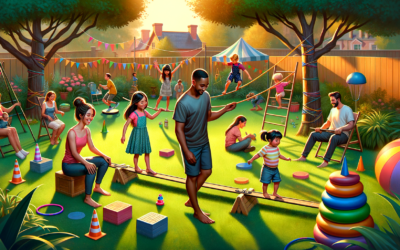Table of Contents
- Introduction
- Nature-Inspired Scavenger Hunts
- Photo Scavenger Hunt Challenge
- Sensory Scavenger Hunt Experience
- Alphabet Scavenger Hunt Adventure
- Glow-in-the-Dark Night Hunt
- Conclusion
Introduction
Did you know that 85% of parents believe outdoor play is crucial for their children’s development? Well, get ready to transform your backyard into an adventure playground with our exciting scavenger hunt ideas! As a parent and outdoor enthusiast, I’ve curated 15 fantastic backyard scavenger hunt ideas that’ll have your family laughing, learning, and bonding in no time. From nature-inspired quests to high-tech treasure hunts, there’s something for everyone. Let’s dive in and make 2024 the year of unforgettable backyard adventures!
Nature-Inspired Scavenger Hunts
Nature-Inspired Scavenger Hunts can be both educational and exhilarating for kids. Just imagine the excitement in their eyes when they spot a ladybug or a rare leaf they’ve been searching for!
When I first started creating these scavenger hunts for my own family, I began with a list of common backyard plants and animals. This gets the kids off to a good start and makes the whole adventure easier and more fun. I’d jot down things like clover, dandelions, and oak leaves. For the critters, I would include ants, pill bugs, and earthworms. One time, we took it up a notch and added a rare sighting challenge—a squirrel or a blue jay. Trust me, the kids loved it and it stirred this competitive spirit you wouldn’t believe!
Incorporating seasonal elements into your scavenger hunt elevates the entire experience. For instance, in the fall, you can ask the kids to find different types of fall leaves: maple, oak, and birch leaves, each with their unique colors and shapes. The crispy sound of stepping on fallen leaves adds another sensory layer to the hunt, making it even more memorable. In the spring, you can have them search for budding flowers like tulips, daisies, or even dandelions. It’s a fabulous way to teach them about seasonal changes and plant biology without them even realizing they’re learning.
One mistake I made early on was not having magnifying glasses ready. The kids missed out on the intricate details of smaller creatures and plants. So, I made sure the next time we had these handy tools. Let me tell you, it changed the game! When my youngest found a tiny caterpillar munching on a leaf and then looked at it through the magnifying glass, the gasp and the wide eyes were totally worth it. They started noticing the tiny hairs on leaves, the segments on bugs, and even the texture of tree barks. It turned an ordinary scavenger hunt into a mini science expedition.
Of course, there are always hiccups. Once, we spent an hour looking for a ladybug, and the kids got a bit frustrated. The thing is, it’s crucial to keep the atmosphere light-hearted. I turned it into a little lesson on patience and nature’s unpredictability. Plus, it made finally spotting that elusive ladybug all the sweeter.
To keep things interesting, I sometimes throw in a “free find” option where any unique item they find can be a wildcard. My son once found a cool-looking rock that had tiny crystalline structures. We didn’t even know what it was but it led us to some fascinating Google searches later!
If you have a mix of ages participating, tailoring the difficulty level is key. Younger children can look for more obvious items like a daisy or a large beetle, while older kids can be tasked with finding something more challenging like a specific type of tree bark or an unusual insect. Keeping the challenge scaled to their abilities keeps everyone engaged.
And don’t forget the power of storytelling! Create little backstories or riddles for each item they need to find. “Legend says the ancient oak tree’s leaves turn to gold when touched by twilight. Can you find one?” It adds a magical element that keeps young minds engaged.
In a broader sense, these scavenger hunts have made my kids more observant and curious about their surroundings. Now, they often notice little details in the backyard that I would have totally missed. They even started keeping a nature journal! I believe it’s these small experiences that foster a lifelong appreciation for the natural world.
Photo Scavenger Hunt Challenge
Remember those days of scavenger hunts when we were young, running around the neighborhood or the park? Well, how about kicking it up a notch and making it a photo scavenger hunt challenge in your own backyard! It’s not only fun but also a fantastic way to get everyone moving and observing their surroundings more closely.
First off, gather everyone and hand out a list of items or scenes to photograph. You can use smartphones, which makes sharing and comparing super easy. But if you’re feeling nostalgic or want to unplug for a bit, give them disposable cameras. There’s something magical about snapping a photo and waiting to see how it turns out, just like we did back in the day.
A great way to start is with a mix of easy finds and more creative prompts. For instance, start with something like “a flower in bloom” – most backyards, even the smallest ones, have some plants or flowers. Then throw in more whimsical prompts like “something that makes you smile.” I had this on our list last summer, and my daughter took a picture of our dog lounging on its back, paws in the air. Totally cracked us up!
Next, look for “an interesting shadow.” This one gets people moving around, bending down, and looking up to play with light and angles. It’s fun to see the different perspectives people capture. My son found a shadow cast by the old treehouse in our yard, and even though it was a simple capture, the shadow’s intricate details were breathtaking.
Another fun item is “something beginning with the first letter of your name.” It personalizes the hunt and makes participants think a bit. For my name, I had to hunt far and wide, but I clicked a photo of a lucky four-leaf clover – the only one in sight! It was a small victory, but hey, that’s part of the fun.
For a bit of a challenge, include something like “a pattern in nature.” This gets everyone looking closely at leaves, bark, or even the arrangement of pebbles. It’s fascinating to see what everyone discovers. One of the most delightful photos was of the spiraling pattern of a snail’s shell that my husband found.
You can spice things up by adding seasonal items to your list. In the fall, you could include “a colorful leaf” or in spring, “a bird’s nest.” Tailoring the prompts to the seasons keeps things fresh and interesting. Last spring, my little girl captured a perfect shot of a newly formed robin’s nest, and it was captivating to see the tiny speckled eggs just waiting to hatch.
Now, don’t worry if not everything goes as planned. We once had a prompt to find “something blue” in early spring, and while I imagined the clear sky, my niece photographed her brother’s blue sweatshirt casually tossed aside. It wasn’t what I had in mind but it was creative and totally unexpected.
When all the photos have been taken, gather everyone to share their favorite shots. Make it a mini show-and-tell where each person explains why they chose that particular subject. It’s funny, heartwarming, and yes, sometimes hilariously unpredictable! Keep things light and positive – the goal is to enjoy and appreciate the little details in your own backyard.
So grab those cameras, get your list ready, and dive into the joy of a backyard photo scavenger hunt. It’s genuinely a fantastic way to spark creativity, enjoy nature, and make lasting memories with your family. Happy hunting!
Sensory Scavenger Hunt Experience
Alright, let’s dive into the sensory scavenger hunt experience! This was one of my absolute favorite activities to set up for the kiddos. The sheer joy on their faces as they explored the backyard with all their senses—priceless! A sensory scavenger hunt is all about engaging sight, sound, smell, touch, and taste. Trust me, the sensory delight enhances the fun tenfold.
So, let’s kick things off with sight. You can include items that are visually stimulating—perhaps a brightly colored flower or a uniquely shaped leaf. I remember including a shiny rock that caught my eye. Watching the kids’ excitement as they spotted it among the grass felt like winning the lottery. Kids absorb so much through simple observation, plus it’s a great way to sharpen their attention to detail.
Next up, sound! Incorporating auditory elements is a blast and not as tricky as it sounds. One time, I hid an old wind chime in a tree. Now that was interesting—a bit of a funny struggle initially because it kept moving with the wind, but the delight when the kids honed in on the gentle tinkling was worth it. You could also use a small, battery-operated device with nature sounds. Just ensure it’s not too loud, so it adds to the challenge.
Touch is my favorite—I kid you not! The giggles and exclamations as the little ones discovered different textures were so genuine. Think about items with varied textures: a smooth pebble, a fuzzy leaf, or even something slightly squishy like a soft sponge. Once, I even sneaked in a garden hose for a surprise splash of water. They loved it! Just keep a towel handy—it can get a bit messy.
Now, let’s not forget smell. It’s often overlooked, but kids are fascinated when they find something through scent. Fresh herbs from the garden like rosemary or mint work wonders. The unmistakable fragrance guides them in a way that’s simple yet thrilling. I’ve also used lemons—they’re safe, and the scent is strong. Watching them sniff around like little detectives always makes my day.
Finally, taste—a bit tricky but definitely doable with attention to safety. I usually go for something familiar and safe like fruit. Cut strawberries are perfect—easy to spot and smell. Hide them in clean, reachable places to avoid dirt. Just last summer, I laid out small bowls of berries; adding an edible element ramps up excitement and, let’s face it, who doesn’t love snacks on the go?
Here’s a handy tip: create a simple checklist for them to follow. Draw icons or minimal words depending on their age. It keeps them organized and lessens the chance of losing focus. You could even turn this into a mini competition with small rewards for each completed sensory category.
In doing this, not only are you setting up a fantastic avenue for sensory development, but also creating lasting memories. Sure, there might be a few oops moments—like the time my carefully hidden lemon slice got too buried under leaves—but every mishap tends to add more fun. Their laughter and sheer wonder outweigh any little glitches.
So there you have it! A sensory scavenger hunt not only boosts their sensory skills but offers a delightful twist to your regular backyard experience. Give it a go and enjoy the sensory adventure right in your backyard. Happy hunting!
Alphabet Scavenger Hunt Adventure
Alright, folks, let me tell you about one of the most fun and educational scavenger hunts that has captivated my family for years—the Alphabet Scavenger Hunt Adventure. It’s a fantastic way to combine learning and playing, and, believe me, it’s equally entertaining for both kids and adults. Here’s how to set it up, and some tips and tricks I’ve picked up along the way.
First things first, this hunt is pretty straightforward: participants are challenged to find items in the backyard that start with each letter of the alphabet. Now, you might think, “How hard can it be?” Trust me, it can be both easy and tough, depending on how creative you get with it. For younger children, you can dial it down a bit by only focusing on the first half of the alphabet, from A to M. Believe me, their little faces light up when they successfully find and identify objects—it’s educational gold!
I remember one memorable hunt where my niece proudly brought me an acorn for the letter A. Simple, right? But imagine my surprise when my nephew busted out “Xylophone” from his toy collection for X. Talk about thinking outside the box! Yeah, X and Z can be real stumpers, but that’s where the creativity comes into play. Encourage the kids to stretch their imaginations. If they can’t find a real “X” in the wild, digging into toys or books they might have forgotten can be a game saver.
You can make the alphabet scavenger hunt as competitive or as relaxed as you want. One year, I split the family into two teams—kids vs. adults. Spoiler alert: the kids won with “Zucchini” from the garden and “Quartz” from a rock collection. Every time a participant finds an item, they have to explain why it fits the letter, which is a sneaky way to boost their reasoning and vocabulary skills.
For those more challenging letters, don’t shy away from giving hints. Little nudges like “X can sometimes be found in the sky during festivals” (for “X” in “fireworks”) can help them see things in a new light. I’ve tried themes, too, like nature-based words only, or items that are mostly red. It can make the hunt either a piece of cake or, well, a bit more like a brain teaser.
Pro tip: Keep a checklist handy so nobody forgets which letters they’ve already covered. Plus, it’s a handy way to prevent moments of dispute—trust me on this one! Also, it helps to set a time limit to add a bit of urgency. About an hour works well for us, keeping the energy high and the game rolling.
Preparation is key. You don’t want to be scrambling for items or rules mid-game. Setting clear guidelines about where they can hunt and what counts as a legitimate find upfront can save you future headaches. Enlisting older kids or another adult to help monitor and judge the items ensures the game runs smoothly.
And hey, it’s not restricted to just the backyard. Neighbors’ front yards (with permission, of course), local parks, or even indoors if the weather isn’t cooperating can be just as fun.
So next sunny afternoon, instead of the usual video game marathon or Netflix binge, try this alphabet scavenger hunt. It’s a perfect blend of fun and learning that can keep everyone on their toes. You might just be surprised by what your family can come up with! Happy hunting!
Glow-in-the-Dark Night Hunt
The concept of a Glow-in-the-Dark Night Hunt is an absolute game-changer for family fun, especially during those warm summer evenings. Trust me, I learned about this innovative twist on the classic scavenger hunt almost by accident. One balmy evening, we were sitting in the backyard, the kids’ initial excitement fading as darkness set in. Then it hit me: why not light up the night with a glowing treasure hunt?
First things first, you’ll need to round up your supplies. Glow sticks are a must-have. You can get these in a variety of color packs, and they’re super easy to snap, shake, and hide. But, if you want to take it up a notch, fluorescent paint is your best friend. Just a heads-up though, make sure you get the non-toxic, washable kind if you’re painting objects the kids will handle. One mistake I made was overestimating the amount of paint I’d need—turns out you don’t need much, and a little glows a lot in the dark!
Now, when hiding your glowing objects, think about varying the difficulty to suit different age groups. This was something I learned the hard way. The first time we did this, I placed all the objects in obvious spots, and the older kids got bored fast. So mix it up; tuck some glow sticks under plant leaves, drop a few inside hanging flower pots, and don’t be afraid to go high and low. The more creative, the better.
Timing is everything. Start your hunt just after dusk, when the sky is dark enough to make everything glow but still light enough for everyone to move around safely. Once, we waited until it was pitch dark, and it got a bit too challenging to navigate the backyard without flashlight assistance—less fun, more stumbling.
A little tip: You might want to lay out some glow-in-the-dark tape or string along unlit pathways or tricky areas. These can act as guides to keep everyone on track and avoid any unfortunate trips or falls. Safety first, right?
When it comes to the actual hunt, I found adding a storyline boosts engagement. One time, we crafted a pirate theme, dubbing glow sticks as “glowing treasures” left by an old buccaneer. Another occasion, it was an alien invasion, and the glowing items were “alien artifacts.” Themes raise the stakes and bring an extra layer of fun to the adventure.
Speaking of themes, don’t shy away from adding props. I once made the mistake of sticking solely to glow sticks, but when we started integrating objects like mini flashlights, glowing bracelets, and even neon chalk drawings, it truly elevated the whole experience. Just imagine the joy of discovering a glow-in-the-dark lollipop after trekking through the backyard!
After a few hunts, I realized adding a reward system upped the excitement. We started with simple cool-down drinks, maybe some popsicles or cold lemonade, as soon as the hunt ended. Not only do the kids look forward to it, but it also became a lovely debrief time to discuss the funniest or hardest-to-find items. This is where the memories are truly solidified and laughs are shared—our own impromptu reflection session.
In essence, a Glow-in-the-Dark Night Hunt combines the thrill of discovery with the magic of a summer night. It’s perfect for family bonding, sparking creativity, and it brings everyone together even after the sun dips below the horizon. So, light up the night and let the hunt begin!
Conclusion
There you have it, folks! 15 incredible backyard scavenger hunt ideas to keep your family entertained and connected with nature throughout 2024. Whether you’re battling screen time addiction or simply looking to create lasting memories, these hunts are sure to do the trick. Remember, the key is to adapt each idea to your family’s interests and your backyard’s unique features. So, what are you waiting for? Grab your list, gather the troops, and let the backyard adventures begin! Who knows? You might just discover a whole new world right outside your door!




0 Comments